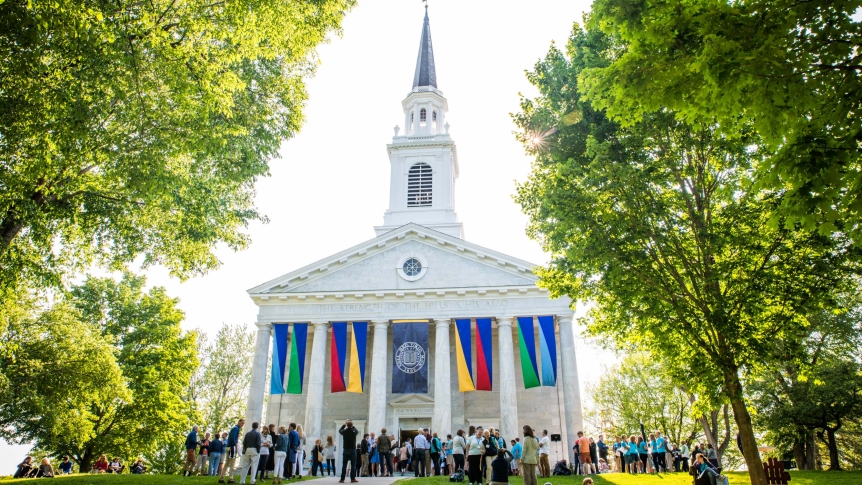History of Middlebury Chapel

This beautiful white marble structure rises on the highest point of the campus, its spire symbolizing the aspirations of the College.
The light which shines here nightly is seen in the entire valley. Over the portal are carved the words from Psalm 95:4, “The Strength of the Hills is His Also.”
When John Thomas became president in 1908, the chapel room in Old Chapel had become inadequate and unattractive. Other needs had to come first, but in 1914 Thomas persuaded Dr. John A. Mead ‘64, to contribute up to $60,000 for a new chapel. Mead was a Rutland, Vermont physician and industrialist, a former Governor of Vermont, and College Trustee. When his gift proved to be insufficient for a marble structure, Mead and his wife later contributed another $15,000, which also covered the cost of a chime of eleven bells in the tower. Even then, the rear or west end of the chapel had to be constructed of wood. As Mead requested, the chapel was located on the high point of land, and became the center of the west side of the new campus quadrangle.
Architecture
The style of architecture was a matter of controversy, which ended in compromise. The floor plan follows the New England meeting-house style, with the door at the front end. The façade is a Greek Revival temple colonnade of marble; the doors and the windows in the marble sides are Georgian; the spire is Federal. The interior is a tasteful Georgian- inspired paneled sanctuary in stained wood.
Services
The chapel services were then an essential part of the students’ day. They were held at 10:00 a.m., Monday through Saturday, and served as a general College meeting. Attendance was taken by monitors, with penalties for more than three absences per semester. Men sat on one side of the aisle, women on the other, no mixing. Official and student notices for the day were read by the senior class president. President Moody or some senior faculty member presided. The service consisted of two hymns, scripture reading, prayer, and a five-minute talk. Sunday Vespers were held at 5:00 p.m., attendance also required unless excused to attend church in the village. A visiting clergyman usually preached. During the 1920’s and 1930’s, the chapel added greatly to the cohesiveness of the College as “I’ll meet you on chapel steps” served as a way of confirming an engagement.
Changes Over Time
As the College grew, changes were inevitable. The balconies were added in 1938, increasing the seating capacity to 715. The war years and the presence of the Navy V-12 Unit changed the schedules. By 1950, with the student population approaching 1200, attendance was required of only half the College one day a week on an alternating basis. Occasional “Assemblies” on academic business required attendance on Friday or Saturday. All requirements have now been dropped.
An altar replaced the original armchairs at the back of the chancel in 1952. The little Sunderland Chapel was created at the right, and is used for small prayer meetings. The original organ was replaced in 1971 by the large Gress-Miles organ. The tower now holds a wonderful 48-bell carillon, gift in 1986 of Allen Dragone ‘50 and his wife Jane, cast and tuned in France from the original bells and other sets. It is played regularly in the late afternoon.
Beginning in 1937, a Chaplain was appointed to lead the chapel services, organize the Sunday Vespers with their visiting clergymen, and encourage the religious life of the College. The Rev. Charles Scott served with distinction from 1951 to 1986. The current chaplain is Mark Orten. Rabbi Danielle Stillman serves as associate chaplain, and Saifa Hussain is associate chaplain and Muslim advisor.
The Chapel Name
Middlebury removed the name “Mead” from its chapel in 2021 because of Governor John A. Mead’s role in advancing eugenics policy in the early 20th century. The building is now referred to as Middlebury Chapel. The decision was made by Middlebury leadership following a recommendation by a working group of faculty, staff, students, and alums. The working group carefully considered the issue and the complexities involved: the immorality of eugenics practices, the historical context and conventions of the time, and the awareness that the chapel—and the ceremonies and events that have taken place within it—has deep personal, spiritual, and cultural meaning for generations of Middlebury people. More context can be found here.
The Chapel Today
Middlebury Chapel is still the center of great activity. The academic year is framed by Convocation in September and Baccalaureate in May. Though its origins lay in the Protestant tradition, the College now welcomes students of all religious faiths and from all parts of the globe. The Chaplain’s Office sponsors worship services, dinners, lectures and other events. Newman, InterVarsity Christian Fellowship, Hillel, the Islamic Society are among the many student religious organizations that are active on campus. The College Choir and the Chamber Choir present a broad repertory of sacred and secular music throughout the year. The Chapel also hosts lectures, concerts, and other major public events. It continues to serve, despite changing times, as the place where the College community comes together on occasions of significance.

